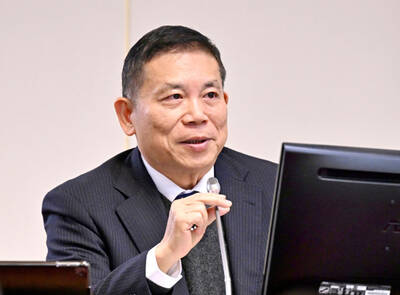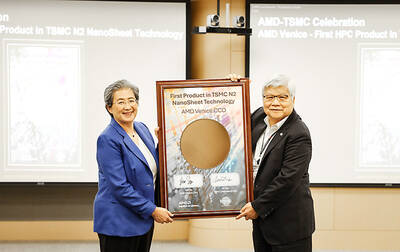Seven offshore wind farm developers have secured government contracts to build 10 offshore wind farms along the western coast of Taiwan as the government aims to build up 5.5 gigawatts (GW) of offshore wind power capacity by 2025, the Ministry of Economic Affairs said yesterday.
The 10 projects would have a total capacity of 3.836GW by 2025, the ministry said in a statement after the completion of a two-stage selection process over the past two weeks.
The ministry would hold an auction by the end of next month to select offshore wind farm developers to build the remaining 1.66GW capacity, Deputy Minister of Economic Affairs Kung Ming-hsin (龔明鑫) told a news conference.
“Those who did not win contracts are allowed to participate in the auction,” Kung added.
Seven wind farms off the coast of Changhua County would have the largest capacity — 2.4GW — by 2025, while three in Taoyuan, Miaoli and Yunlin will have a combined capacity of 1.436GW.
Two wind farms — separately operated by Swancor Holding Co Ltd (上緯) and Wpd Taiwan Energy Co Ltd (達德能源), the local subsidiary of Germany-based Wpd Group — would together generate 0.738GW by 2020, the ministry said.
From 2021 to 2025, the Wpd Taiwan unit in Yunlin and eight other wind farms, whose developers comprise four foreign investors and two government-backed companies, would generate 3.098GW of electricity, it said.
The developers of the eight wind farms are Wpd Taiwan, Denmark’s Orsted A/S, Copenhagen Infrastructure Partners (CIP), Canada’s Northland Power Inc (NPI), China Steel Corp (CSC, 中鋼) and state-run utility Taiwan Power Co (Taipower, 台電), the ministry said.
Between 2021 and 2025, Wpd Taiwan plans to bring online another wind farm off Taoyuan, while Orsted and CIP would operate two farms in Changhua.
CSC, Taipower and NPI would each operate one wind farm off Changhua during the period, ministry data showed.
There are still some challenges for the developers to overcome before their wind farms can connect to the grid, Bureau of Energy Director-General Lin Chuan-neng (林全能) said, citing deposits and construction permits.
In addition, the companies are required to draft “localization” plans to explain how they will boost ties with Taiwanese suppliers, as the ministry plans to build a local supply chain for wind turbines and undersea foundations, Lin said.
The project to ramp up offshore capacity by 2025 is expected to generate about 20,000 jobs and attract investments valued at NT$962.5 billion (US$32.51 billion), data showed.
The ministry said two local companies, cement producer Asia Cement Corp (亞泥) and textile supplier Lealea Enterprise Co (力麗), did not win wind farm contracts.
In related news, Taipower yesterday signed a NT$25 billion procurement contract with Luxembourg-based marine construction company Jan De Nul Group and Japan’s Hitachi Ltd to build 21 offshore wind turbines in Changhua’s Fangyuan Township (芳苑).
Each turbine would have an installed capacity of 5.2 megawatts, Hitachi said in a statement.
The three companies would start examining the ocean bed off Changhua this month and the construction of the turbines is scheduled to start next year, it said.

Taiwan will prioritize the development of silicon photonics by taking advantage of its strength in the semiconductor industry to build another shield to protect the local economy, National Development Council (NDC) Minister Paul Liu (劉鏡清) said yesterday. Speaking at a meeting of the legislature’s Economics Committee, Liu said Taiwan already has the artificial intelligence (AI) industry as a shield, after the semiconductor industry, to safeguard the country, and is looking at new unique fields to build more economic shields. While Taiwan will further strengthen its existing shields, over the longer term, the country is determined to focus on such potential segments as

UNCERTAINTY: Innolux activated a stringent supply chain management mechanism, as it did during the COVID-19 pandemic, to ensure optimal inventory levels for customers Flat-panel display makers AUO Corp (友達) and Innolux Corp (群創) yesterday said that about 12 to 20 percent of their display business is at risk of potential US tariffs and that they would relocate production or shipment destinations to mitigate the levies’ effects. US tariffs would have a direct impact of US$200 million on AUO’s revenue, company chairman Paul Peng (彭雙浪) told reporters on the sidelines of the Touch Taiwan trade show in Taipei yesterday. That would make up about 12 percent of the company’s overall revenue. To cope with the tariff uncertainty, AUO plans to allocate its production to manufacturing facilities in

COLLABORATION: Given Taiwan’s key position in global supply chains, the US firm is discussing strategies with local partners and clients to deal with global uncertainties Advanced Micro Devices Inc (AMD) yesterday said it is meeting with local ecosystem partners, including Taiwan Semiconductor Manufacturing Co (TSMC, 台積電), to discuss strategies, including long-term manufacturing, to navigate uncertainties such as US tariffs, as Taiwan occupies an important position in global supply chains. AMD chief executive officer Lisa Su (蘇姿丰) told reporters that Taiwan is an important part of the chip designer’s ecosystem and she is discussing with partners and customers in Taiwan to forge strong collaborations on different areas during this critical period. AMD has just become the first artificial-intelligence (AI) server chip customer of TSMC to utilize its advanced

Chizuko Kimura has become the first female sushi chef in the world to win a Michelin star, fulfilling a promise she made to her dying husband to continue his legacy. The 54-year-old Japanese chef regained the Michelin star her late husband, Shunei Kimura, won three years ago for their Sushi Shunei restaurant in Paris. For Shunei Kimura, the star was a dream come true. However, the joy was short-lived. He died from cancer just three months later in June 2022. He was 65. The following year, the restaurant in the heart of Montmartre lost its star rating. Chizuko Kimura insisted that the new star is still down